
MY “EVERYDAY CARRY” ART TOOLS
One of the most common questions creators get asked is “what _____ do you use?” (It’s okay – I used to ask the same questions when I was starting out.) It can be “what pen…” if you’re an artist, or “what markers…” if you’re a colorist. “What software…?” if you create artwork digitally, or even if you’re a writer. Sometimes writers even get asked if we use paper, notebooks, a typewriter (if the person asking is old enough), or the most common, PC or Mac? Folks either just starting out, or with aspirations to enter a creative industry always want to know what tools are used by creators they see as having already “made it” because when we start out, we think in some way the tools help.
Well, they don’t. Not in that way. What really helps is practice. Practice – much to Allen Iverson’s chagrin – is truly the most important part of every artist’s toolbox. However, There are a few tools that you will find most of us carry around because we have found over time they are either just that good… or that good for us. So, what you will find below are the tools I have come to find work best for me over the past ten years of cartooning.
(Full disclosure: I am part of the Amazon Affiliate Program, so if you click on the link and purchase any of the products below with the links, I get a few pennies – literally, Bezzie isn’t that generous – with each purchase.)
DRAWING TOOLS
PILOT HI-TEC COLETO C MULTI PEN
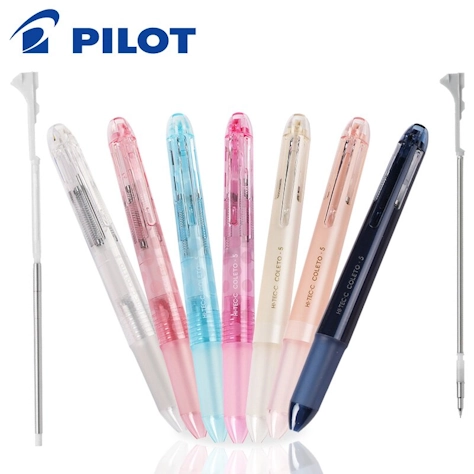
I created my own sketching and drawing pens using the body of the Pilot Hi-Tec Coleto C Multi Pen (the 5-slot body is best for my hand, but they have 4- and 3- slot bodies as well). I added three mechanical pencil inserts and one eraser insert, and a single black gel ink 0.5mm refill. I fill each pencil insert with a different hardness of lead for a variety when sketching or doing layouts. I have four: One each for my main kit, my sketchbook, for travel, and a backup. The pen body link is a 4pk because it’s a better deal than single bodies.
ERASERS
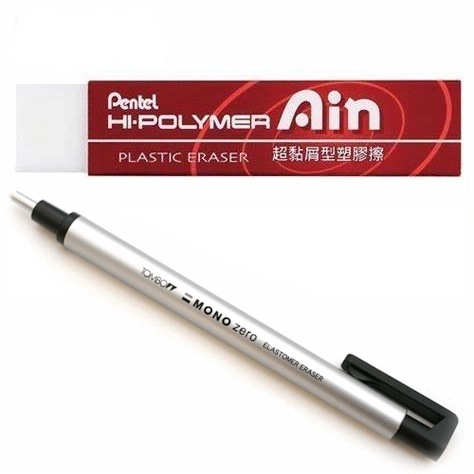
I use several erasers, but there are two kinds I use more than others. I use the Pentel AIN Hi-Polymer in block and stick form for large area erasing. It works perfectly on regular graphite and is also very effective on most colored pencils. I also use the Tombow Mono Zero stick eraser, which is roughly 2mm wide, for precision erasing. It’s softer than the AIN, but is still a nice quality eraser. (I also use a similar stick eraser in the HiTec pen above, for portability, but in my kit, I always have these two. I also carry a Faber castell kneaded eraser, but I forgot to grab a photo.
INKING PENS
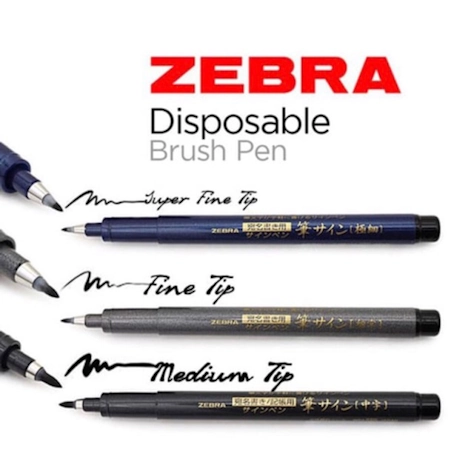
When I was starting out, I asked Chris Samnee which pens he preferred for inking, because I was not ready to ink with a brush. He said, “Zebras.” I got a set, and they didn’t work for me. As it turns out it wasn’t the pens, it was me. I wasn’t ready for them. You’re tools are only as good as you are. Another valuable artists’ tool is patience. It took me a while to learn that the railroading problem with Zebras was not with the pen, but with my impatience in inking. Once I slowed down and took my time, I learned just how fantastic these pens are. They’re lightfast, archival, waterproof, and resistant to alcohol markers. I mostly use the Fine tip pen, and using the Extra Fine for details or smaller pieces of art. (NOTE: The Grey ink Zebra is NOT waterproof!)
- Zebra Brush Pen – Extra Fine
- Zebra Brush Pen – Fine
- Zebra Brush Pen – Medium
- Zebra Fine Point 4pk
- Zebra Extra Fine Point 10 Pack
- Zebra Fine Point 10 Pack
- Zebra Brush Pen 4 Pack (Includes Grey Ink Pen which I *don’t* recommend)
FINE DETAIL PENS
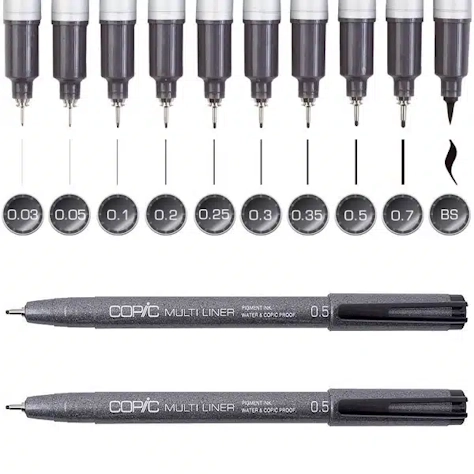
A lot of the fine detail in my work is done with “multiliners,” or pens with tips narrower than one millimeter. These provide a way to add contour and shading to drawings without actually adding color, or detail that a camera might just catch but an eye might miss. I use Copic multiliners mainly because I know they won’t smear or bleed when used with alcohol markers. They offer two versions: disposable and refillable, but I found that the refillable actually creates more non-recyclable waste than the disposable. Go figure. (These links are for the disposables, which I think hold more ink than the refillables, too.)
RULERS
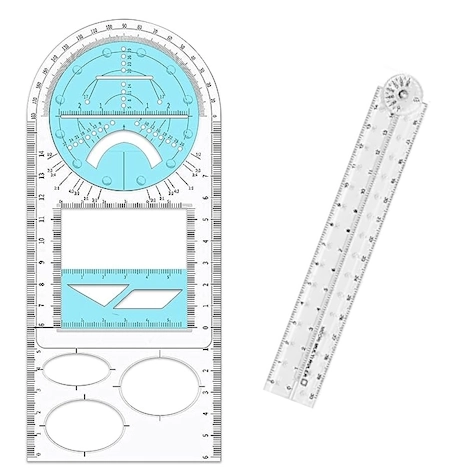
Most of my work is done freehand, but even I need a ruler, protractor, or guide sometime. To maximize space in my kits, I use Japanese specialty rulers, including ones developed for math classes for Japanese students of Geometry. They have more bells and whistles than I need, but they are inexpensive and do a lot of the functions of three of sometimes four tools, saving me plenty of room in my kit. I also carry a Midori ruler, which is a 15 centimeter ruler hinged with a 180-degree dial, allowing the ruler to open up to a 30-centimeter ruler. It also has holes every centimeter, allowing it to also be used as a compass and protractor. I love a good multitasker.
PAPER
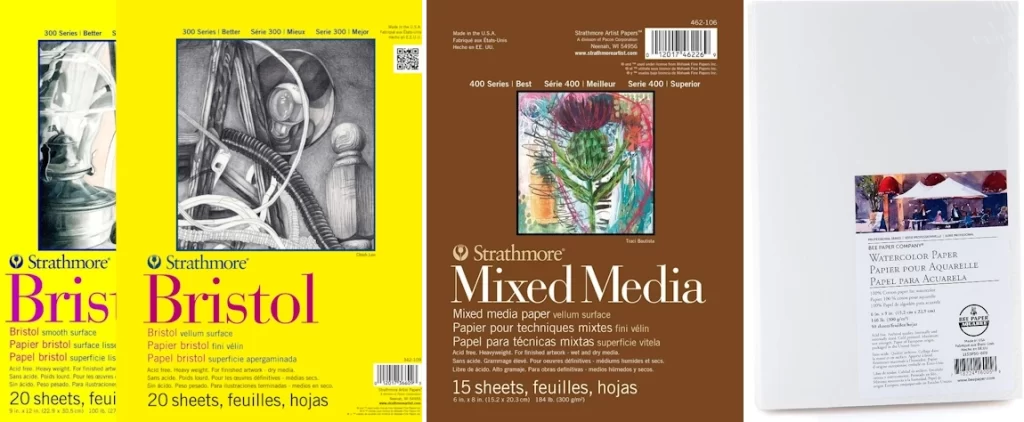
Yes, it’s true that you can draw on any kind of paper. However, if you want your work to last and not worry about it, you’ll buy quality surfaces. For the kind of artwork I do, that means Bristol papers, Mixed Media papers, and sometimes watercolor paper. Strathmore makes some of the better Bristol, and their 300 series is a nice balance of quality and affordability. I generally use smooth Bristol, but they also have vellum (the slightly toothier version) available, too. For most of my own personal work, I use their 400 series Mixed Media paper, which has a slightly toothier finish than the 300 Vellum finish. When I work with watercolors, I use Bee Paper’s cold pressed watercolor paper. (The difference between cold and hot pressed paper is whether the rollers pressing the washed wood pulp into the thin sheets we know as paper are heated or not.) Cold pressed paper is like vellum Bristol, whereas Hot pressed paper is like smooth Bristol.
COLORING SUPPLIES
COLORED PENCILS
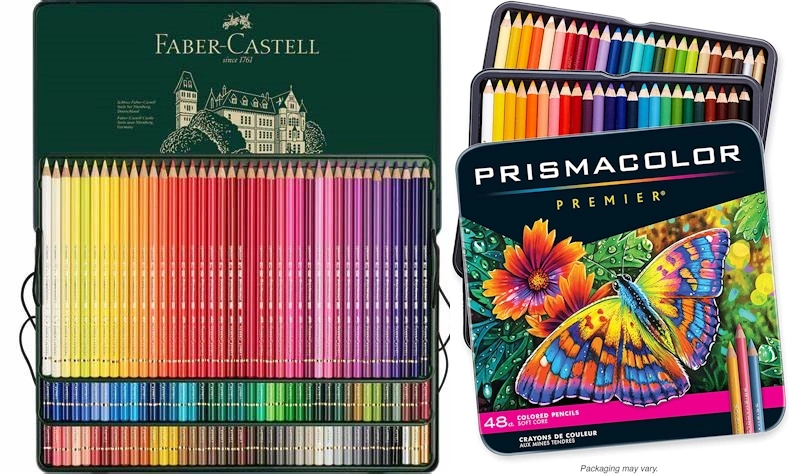
I seem to have moved almost entirely to coloring my traditional art with colored pencils. Which is weird, because I only recently started to feel really comfortable with them. Maybe that’s why? I now use two brands of colored pencil. I use Faber Castell for the first or primary layers of colors, and then for highlights, or should I need a final layer to pop off the page, I use the waxier Prismacolors. The Prismas are harder to control, and don’t blend as well, but they are great for spot colors and bright highlighting.
MARKERS
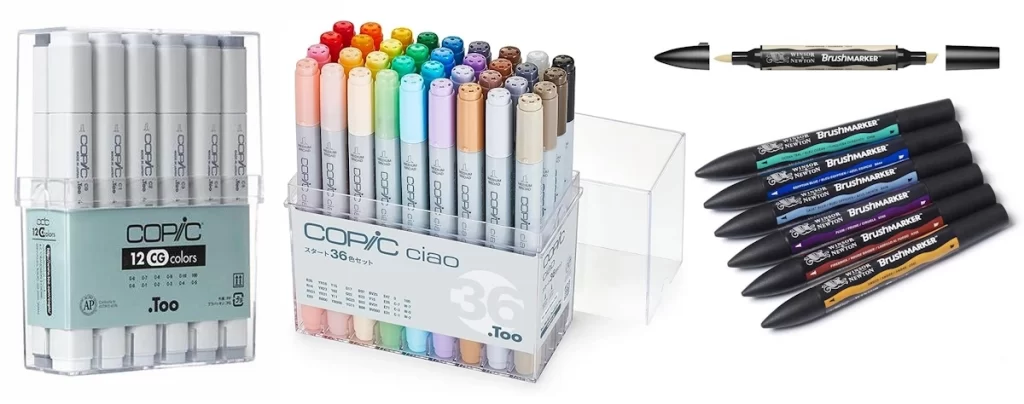
While I am doing most of my coloring work now in colored pencils, I do still use markers. One series, DASH & DOTTIE, is colored entirely in greyscale tones. I am currently using up my stock of Dick Blick markers, which are good starter markers, but the nibs do not last as well as Copics, nor do they have as much ink. Copics are superior blending markers, so I have switched to using Copic Ciao (smaller, less ink, less expensive) for coloring commissions at shows when customers ask for full color commissions. At home, in addition to the greyscale Copics, I also use Winsor Newton Brushmarkers. They have a lot fewer colors, but they are really nice markers, and are based on the old Pantone markers – which W/N used to manufacture.
PAINTING SUPPLIES
SHIN HAN WATERCOLORS

Shin Han is the Chinese brand behind the popular TOUCH markers that were once considered the best alternative to Copics a couple of years ago before the secondary alcohol marker market exploded. Since then, Shin Han has elevated their art supply game, and unfortunately, their prices. However, their paints are still competitively priced when compared to other popular brands, and you can still get sets like this with over 20 colors for the same price as 12-color sets from brands like Winsor or Daniel Smith. When starting out, it’s worth getting more colors than less until you feel more comfortable mixing your own colors. I’ve linked to the 18-color set which is still the best deal.
TRAVEL WATERCOLOR BRUSHES

These are a fairly nondescript set of brushes, I know, and I’m not known for my painting mastery. However, my friend Scott Sava is, and he recommended these brushes, and they are the best brushes I have used yet. They hold water better than any of the natural bristle brushes I have used, and hold their shape quite well. They are also easy to clean and as you can see, they disassemble into a nice, compact kit for traveling… even though I only use them at home.
WINSOR NEWTON TRAVEL WATERCOLOR KIT
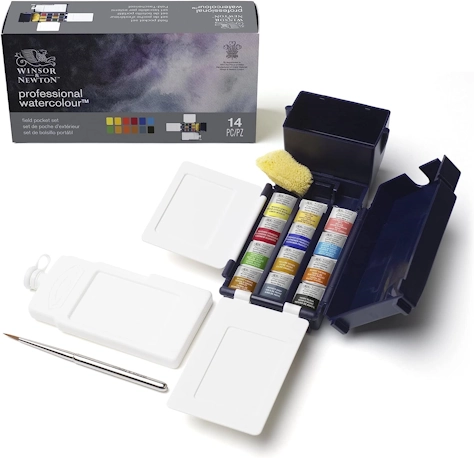
First and foremost, a warning: The price on this thing fluctuates wildly. You will find it priced at roughly $75, so I recommend you drop it into your cart and wait. Every so often, say four to six times a year, it drops to $30 or less. Once it does, it’s time to grab it! The kit includes 12 half-pans of colors from the Winsor Newton Student set of paints, a VERY tiny brush, and fold out flat mixing wells, plus a wee plastic flask for water, and a cap/well for cleaning your brush or filling your brush. I took out the paints and filled the pans with my own paints, saving the WN paints as backups. I also carry my own travel brushes (I don’t recommend the ones I do use, I would order yourself a set of the trio above). This kit is slightly awkward in the wild, but it’s 6x2x1.5-inch profile is amazing for having a portable watercolor kit on the go when you want to sketch anywhere, anytime.
PAINT CLEANER / HOLDER
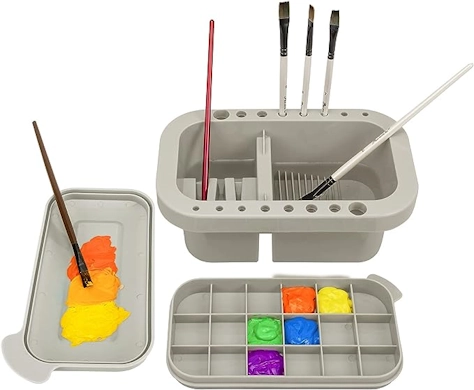
This doodad is a weird but super handy item for when I am painting at home. Now, I never use the top(s) for their intended uses as mixing wells or paint sorters, but the base – that sucker is great! It has two different sections for washing and filling your brushes with water, and the holes along the sides for brush storage. You can just see the ridges on the right well are great for cleaning the brushes fantastically. This is the goofiest but maybe some of the best $15 I’ve spent.
